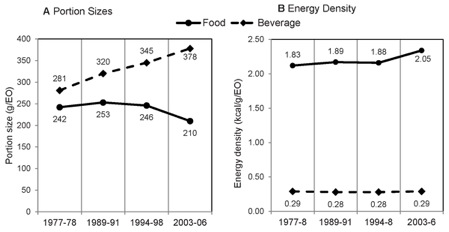Extra Calories: Where Are They Coming From?
In my September 3rd post, I reviewed the data showing that on average people in the U.S. are eating a lot more now than they did 30-40 years ago. In this post I want to give you just a little bit of data about where the calories are coming from. I also hope I can shed some light on comments that both Sheila Ray and Joey Keillor made in response to the September 3rd post.
The graph below gives some clues about the sources of the extra calories. The left panel is about portion size and you can see that beverage portions have gotten bigger in terms of grams/eating occasion (g/EO). The right panel is the energy or caloric density per gram of food per eating occasion. For solid food portion, size is down per eating occasion, but energy density is up so it is a wash. But clearly we are drinking more calories due to bigger beverage sizes. Not shown in this slide is that eating occasions have also increased.
The authors of the study that generated this figure conclude that:
“While all three components (eating occasions, energy density, and portion size) have contributed to some extent to 30 year changes in total energy consumption, changes in eating occasions and portion size have accounted for most of the change. These findings suggest a new focus for efforts to reduce energy imbalances in US adults.”
I should note that the authors of the study also estimate that total daily caloric consumption has increased by about 570 calories per day in adults over the last 30-40 years. This value is in the same ball park as the value shown in the first chart from the USDA in the September 3rd post and on the high side of estimates for increased calorie consumption over time. Again, whatever the estimates it is pretty clear the population as a whole is eating more calories.
Is it all fructose? Is it all sugar?
One idea that is out there is that all of this weight gain is due to increased consumption of high fructose corn syrup. This is controversial and a review of key studies on the topic has concluded that:
“Fructose does not seem to cause weight gain when it is substituted for other carbohydrates in diets providing similar calories. Free fructose at high doses that provided excess calories modestly increased body weight, an effect that may be due to the extra calories rather than the fructose.”
What about fast food?
The information above shows pretty clearly that we are eating more and that sugary drinks are part of the problem. But it is even worse than that. Here is a summary from a study of fast food consumption and obesity in teenagers.
More frequent use of fast-food restaurants that primarily served burgers and french fries was associated with higher risk for overweight/obesity; higher intake of total energy, sugar-sweetened beverages, and fat; and with lower intake of healthful foods and key nutrients. For example, those who reported burger-and-fries restaurant use on three or more occasions per week consumed nearly one additional sugar-sweetened beverage per day compared to those who reported burger-and-fries restaurant use on less than one occasion per week.
Summary
The data discussed above was used to give a snapshot of key things contributing to the “supply side” of obesity crises:
- Bigger portions sizes.
- More eating occasions.
- More calories are coming from sugary drinks, but high fructose corn syrup is a problem mainly due to the extra calories.
- Too much fast food consumption as well as the types of fast foods make a difference.
When you see this data you can see why there is a push in places like New York City to limit the portion sizes for sugary drinks. My personal opinion is that while there may also be subtle differences in metabolism and all calories may not in fact be created equally, these issues are likely “small potatoes” when you consider the magnitude of the overeating problem. So, the message is eat less per serving, eat less often, and carefully monitor how often and what kind of fast food you eat. In future posts I will explore why this is so hard to do.
This entry was posted on Monday, September 10th, 2012 at 7:16 am and is filed under Current Events, Research and Health. You can follow any responses to this entry through the RSS 2.0 feed. You can leave a response, or trackback from your own site.



September 11th, 2012 at 2:21 pm
It might sound perverse, but I wonder if there is a correlation between reduced cigarette smoking (and/or the bygone three martini lunch) and increased obesity? It’s like humans have an evolutionary need to be constantly putting things in the mouth (insert lewd joke here). It used to be that there wasn’t anything available to constantly be eating…then when there was, post WWII, everyone substituted cigarettes for food. Now, smoking rates are much less, but food and pop is the substitute for cigarettes.